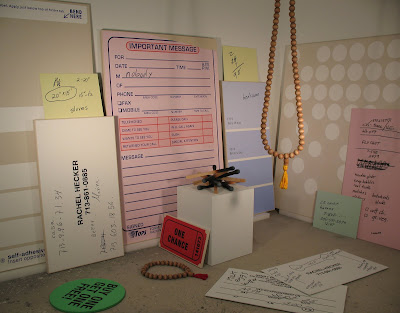 Studio view 2007
Studio view 2007
For the past several years, I have been making paintings of my hand written lists, notations, appointment cards, half-used sheets of stickers/labels, and other accumulated paper detritus. I am interested in the unselfconscious nature of the imagery and the unintentional poetry, and how these collections become inadvertent diaries of how we exist in the world, exposing foible, banality, repetition, desire, expectation, habituation, ritual, hopefulness and doubt. I refer to this work as painting for convenience, but I approach and think of it as sculpture. What I am trying to do is to remake rather than represent things. Given this criteria, I prefer to present the work relationally, fully cognizant of space, and resisting the stasis of the wall. The work seen below- while made up of 40 component parts - was not complete until it was installed for a show that I did in 2009 at Texas Gallery in Houston called “my world is really small and you are in it.” The work was stacked against two long facing walls. Here are two installation views:
 my world is really small and you are in it, 2009, East Wall, 22 paintings, 45’ length, Texas Gallery
my world is really small and you are in it, 2009, East Wall, 22 paintings, 45’ length, Texas Gallery
 my world is really small and you are in it, 2009, West Wall, 18 paintings, 45’ length, Texas Gallery
my world is really small and you are in it, 2009, West Wall, 18 paintings, 45’ length, Texas Gallery
I still make these paintings when something strikes me as particularly poignant, but I also find myself moving towards images that question painting in general, and my sense of repetitious failure in particular. When I finish a piece, and I am always disappointed that it is “just” a painting or a sculpture or a drawing. I expect the work to do something that it can’t do - to resist its own inertia. I don’t believe in objective reality, so the things that exist as matter - including my own work - appear as the props of phantasmagoria. What is interesting to me now is the fact that I continue to make work (with respect and love) that can only end in failure, and I am taking this on more directly in the form of content. For example, I am working on paintings that I call “Paintings that Do Something”, which I interpret as a non-sequitur, and I recently tried to “rescue” a portrait that I painted of my brother by implanting it with natural eyelashes, as a way to enliven it.
 Studio view, 2010
Studio view, 2010
Paintings that do something / Anamorphic Skull, 2010, acrylic on canvas, 20” x 96”
Left - Right:
We Closed, 2009, acrylic on canvas, 60” x 84”
Love Daddy, 2010, acrylic on canvas, 14” x 22”
Paintings that do something / Scintillating Hermann Grid, 2009, acrylic on canvas, 72” x 54”
This Item intended for sale at CVS, 2010, acrylic on canvas, 48” x 48”
Paintings that do something / QR Code Painting, 2010, acrylic on canvas, 60” x 60”
Floor:
Visitor Pass, 2010, acrylic on canvas, 20” x 30”
Not Made In China, 2010, acrylic on canvas, 12” x 72”
Fall Risk Bracelet, 2010, acrylic on polystyrene, 16” diameter x 6” x 1/8”
Right Wall:
Portrait of My Brother / Yearbook, 2010, acrylic on canvas with implanted natural eyelashes, 72” x 60”
I carefully hand-paint as an act of redemption - I am trying to save the image. (I do not use vinyl stencils, printmaking, or photomechanical processes). My investments of time and care reflect a belief that value is not endemic to any particular thing, but rather experienced, moment-by-moment. Slow painting is like turning the beads on a rosary.
 Paintings that do something / Anamorphic Skull, (detail: view from left), 2010
Paintings that do something / Anamorphic Skull, (detail: view from left), 2010
The QR Code (above top) is a type of bar code that I first imbedded with a photo of a chimp looking in a mirror (above bottom), then made a painting of that QR code. If you download a QR Code application (free) to your Smart Phone, you can hold your phone camera up to the painting and the QR Code reader will (within seconds) show you the image of the chimp.
Above is a detail from Scintillating Hermann Grid Variation, 2009, acrylic on canvas, 72” x 54”, from “Paintings that Do Something”. This optical illusion is a variation of the optical illusion discovered by E. Lingelbach in 1994, which was a variation of the Hermann grid illusion, discovered by Ludimar Hermann in 1870. The scintillating grid illusion is characterized by random black dots appearing and disappearing at the intersections. You will most likely be able to experience this phenomenon in this detail from my painting.
 Visitor Pass, 2010, acrylic on canvas, 20” x 30” and Fall Risk Bracelet, 2010,
acrylic on polystyrene, 16” diameter x 6” x 1/8”
Visitor Pass, 2010, acrylic on canvas, 20” x 30” and Fall Risk Bracelet, 2010,
acrylic on polystyrene, 16” diameter x 6” x 1/8”
A good friend of mine was recently hospitalized. I try to remember what some people try to forget.
This gives me a heightened sense of exigency.
Visit my website at http://www.rachelhecker.net










